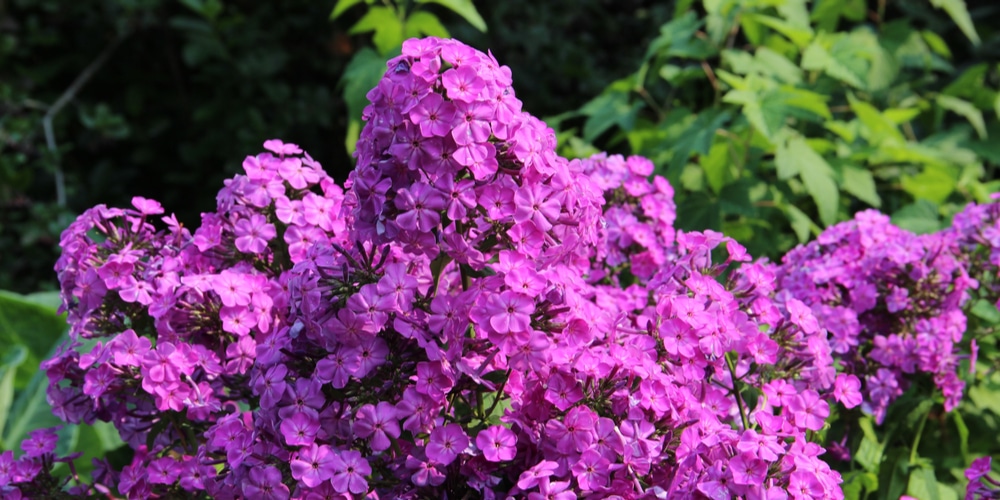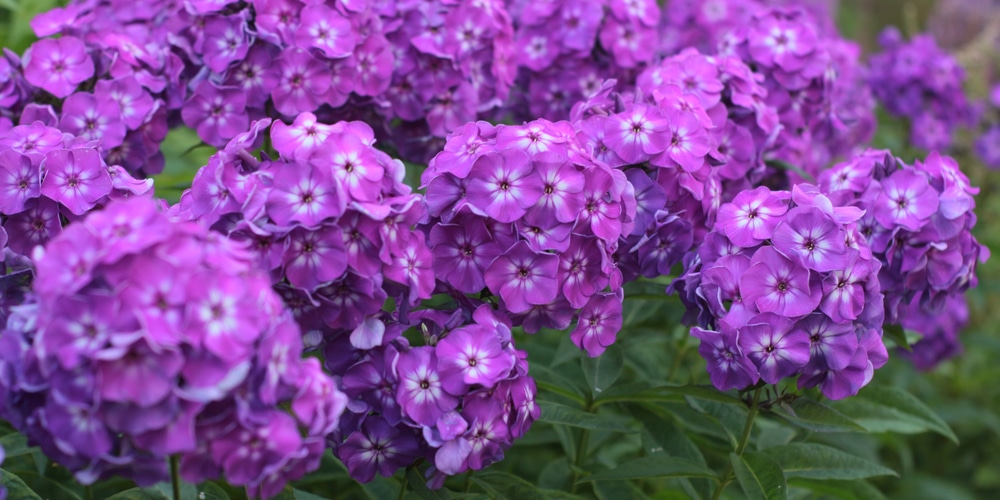If you need to add a splash of color to your garden but have no time to spend effort maintaining your plants, Purple Phlox might be an excellent option for you.
This evergreen perennial is relatively easy to grow and makes for a stunning ground cover. There are many phlox varieties, which might make the choice challenging. But if you are looking for a low-growing plant, purple phlox will serve your needs.
But how can you make the most out of your purple phlox, and what should you know about it? Keep reading this essential guide! Here, you’ll learn the best tips and tricks to grow purple phlox in your garden.
| Botanical Name | Phlox Paniculata |
| Common Name | Purple Phlox or Creeping Phlox |
| Plant Type | Perennial |
| Flower Color | Purple flowers with deep violet centers |
| Size When Mature | About 4-6 inches tall and 12 to 18 inches wide |
| Bloom Time | Mid-spring |
| Sun Requirements | Full Sun |
| USDA Hardiness Zones | 3-9 |
| Soil PH Range | 7.0 – neutral |
| Soil Type | Well-draining and fertile |
| Water Needs | Medium |
| Native Area | Eastern United States |
What you Need to Know About Purple Phlox
Purple phlox produces masses of star-shaped purple flowers that will make your garden a carpet of color between mid-spring and the early summer. Consider training it to grow over a rock wall: the result will be a stunning waterfall of purple!
The best part about purple phlox (and all phlox varieties) is that it is a relatively easy-to-grow plant: it is tolerant to most diseases, deer-resistant, and it thrives even during periods of drought once it establishes itself.
These plants produce a subtle sweet fragrance that contributes to attracting plenty of beneficial pollinators during the blooming season. You can expect hummingbirds, bees, and butterflies to visit your garden often on warm and sunny days.
So, purple phlox is excellent if you need to aid your plants with their reproduction. And we have even more good news: you can enjoy its blooming for about three to four weeks.
If you have pets or kids running around your garden, you won’t have to stress: this plant isn’t toxic to humans or animals.
How to Care for Purple Phlox
As mentioned, growing Purple Phlox isn’t anything out of this world. We recommend you plant it in the spring, after the threat of frost, to allow your plant adequate time to get used to its environment. The good news is that once it establishes itself in the soil, this plant requires little to no maintenance. But you’ll still have to ensure the growing conditions are optimal for this plant. You can learn all about it in the following sections.
Light
This plant prefers full sun, even if it will tolerate partial shade, especially if you live in a warm region. Indeed, if you live in the south, you might have better results exposing your plant to the sunlight in the morning and protecting it from the sun during the afternoon.
Too much lighting might burn your plant’s leaves and dry the soil. In the north, purple phlox grows exceptionally well with full lighting.
Water and Soil Needs
One of the only things you’ll have to pay attention to before planting a purple phlox in your garden is that the substrate you use is well-draining. These plants love moisture but don’t do well in wet conditions. Avoid overwatering your plants.
Also, keep the foliage dry even when adding extra water to minimize the risk of powdery mildew.
Consider adding a layer of mulch around your plants to increase water retention and improve drainage. Such a step is especially crucial if you live in a hot and dry region. Mulch will help regulate the soil temperature and protect your plants from thermal shock.
You can also use a fork or a tiller to prepare your garden bed before planting your phlox. We recommend you loosen the soil to about 12 to 15 inches deep to improve the consistency.
Because purple phlox also needs plenty of organic matter to stay healthy, apply compost or manure to improve the nutrient content in the soil. Luckily, this plant isn’t fussy about pH levels, so you don’t have to worry about amending your soil. However, it performs best in neutral conditions.
This plant also does well in containers, provided that you ensure adequate drainage. Consider removing dead flowers to allow your plant to rebloom.
Temperature Requirements
The purple phlox is a versatile plant. It thrives in various climates and performs well in USDA hardiness zones between 3 to 9. But these plants don’t like hot and humid summers. If you live in the Deep South, you may have to find other options for your garden.
If you live in a cold area, you might have to protect your plant’s roots by applying a thick layer of mulch around the ground before it freezes.
Fertilizer
Under the ideal growing conditions, fertilizer isn’t necessary. Instead, consider lightly pruning your plant after the blooming season. Doing so will maintain your purple phlox in an attractive shape and promote new growth, which will result in more blooms the following season.
If you are worried your plant isn’t receiving adequate nutrition, consider feeding it with a slow-release balanced fertilizer. Use high-quality products to achieve better results and avoid overdoing it: you’ll do more harm than good.
Common Diseases
Growing purple phlox won’t be an issue. This plant is tolerant of most diseases. However, you will have to pay attention to powdery mildew, a fungal infection that thrives in hot and humid conditions.
To prevent that from being a problem for your plants, ensure you keep their foliage dry when watering them.
Also, don’t forget to ensure adequate air circulation: if you are planting more than one specimen, allow for enough spacing between your plants. And don’t forget to thin your plants in the early spring as a preventive measure.
Purple Phlox Care: Final Thoughts
Finally, consider cutting your plant’s stems down to the ground in the fall and removing them. Doing so will minimize the spread of powdery mildew and keep your plant healthy.
Luckily, the plant isn’t susceptible to other pests or diseases, so you can concentrate your efforts on preventing powdery mildew.
Related Article: Purple Indoor Plants to Brighten Your Home


